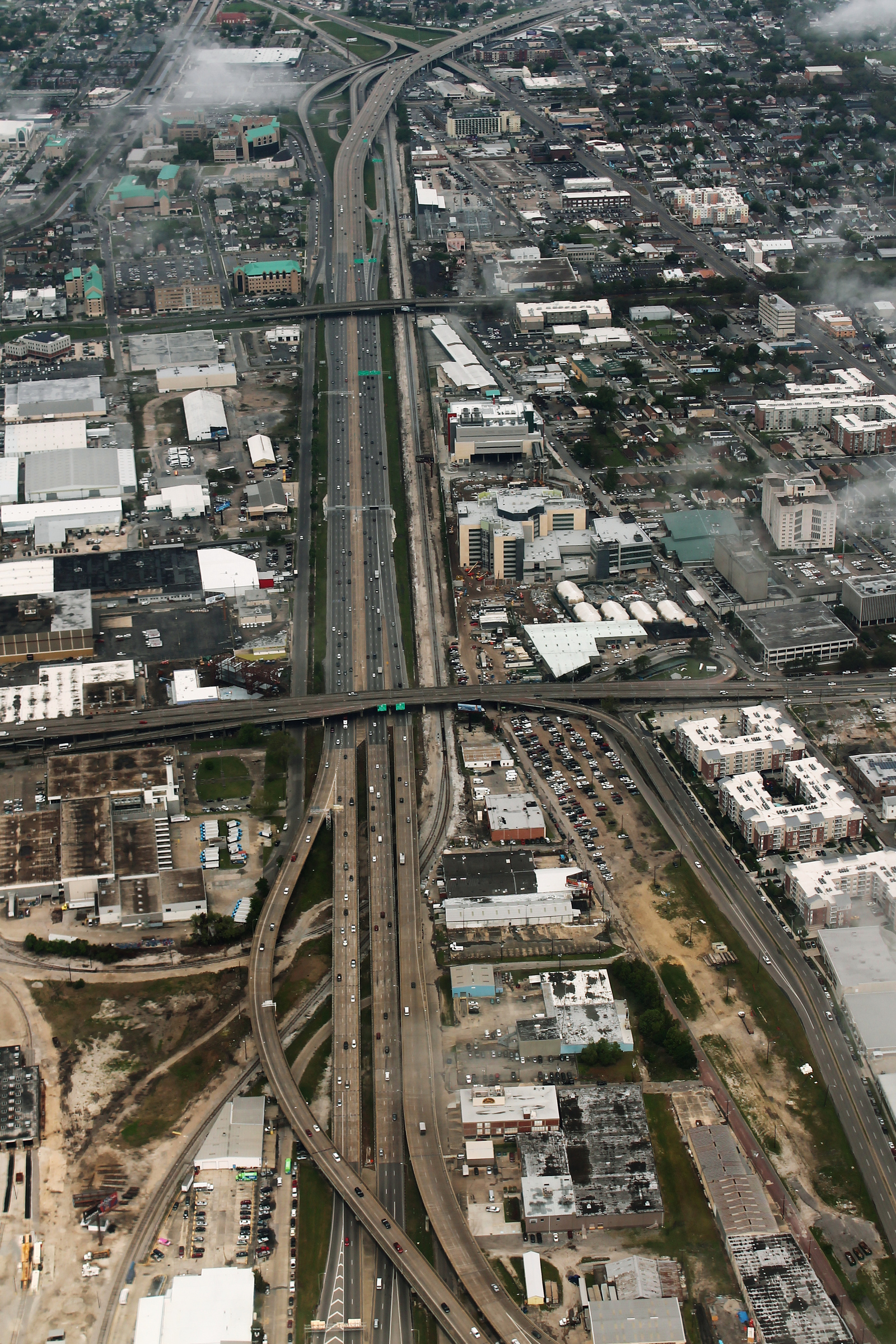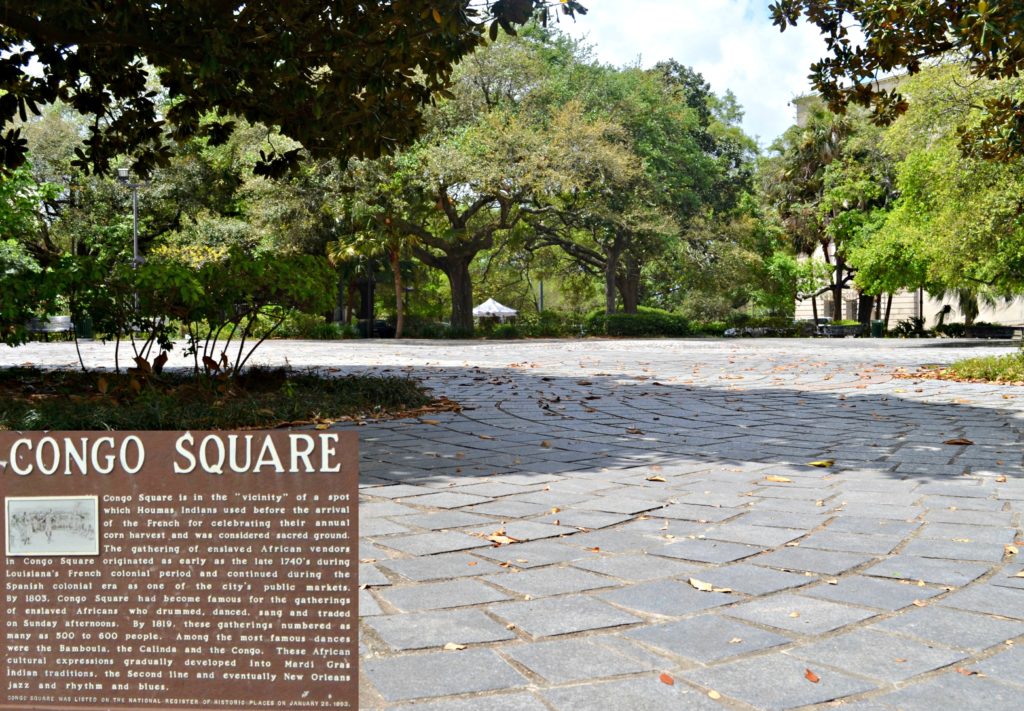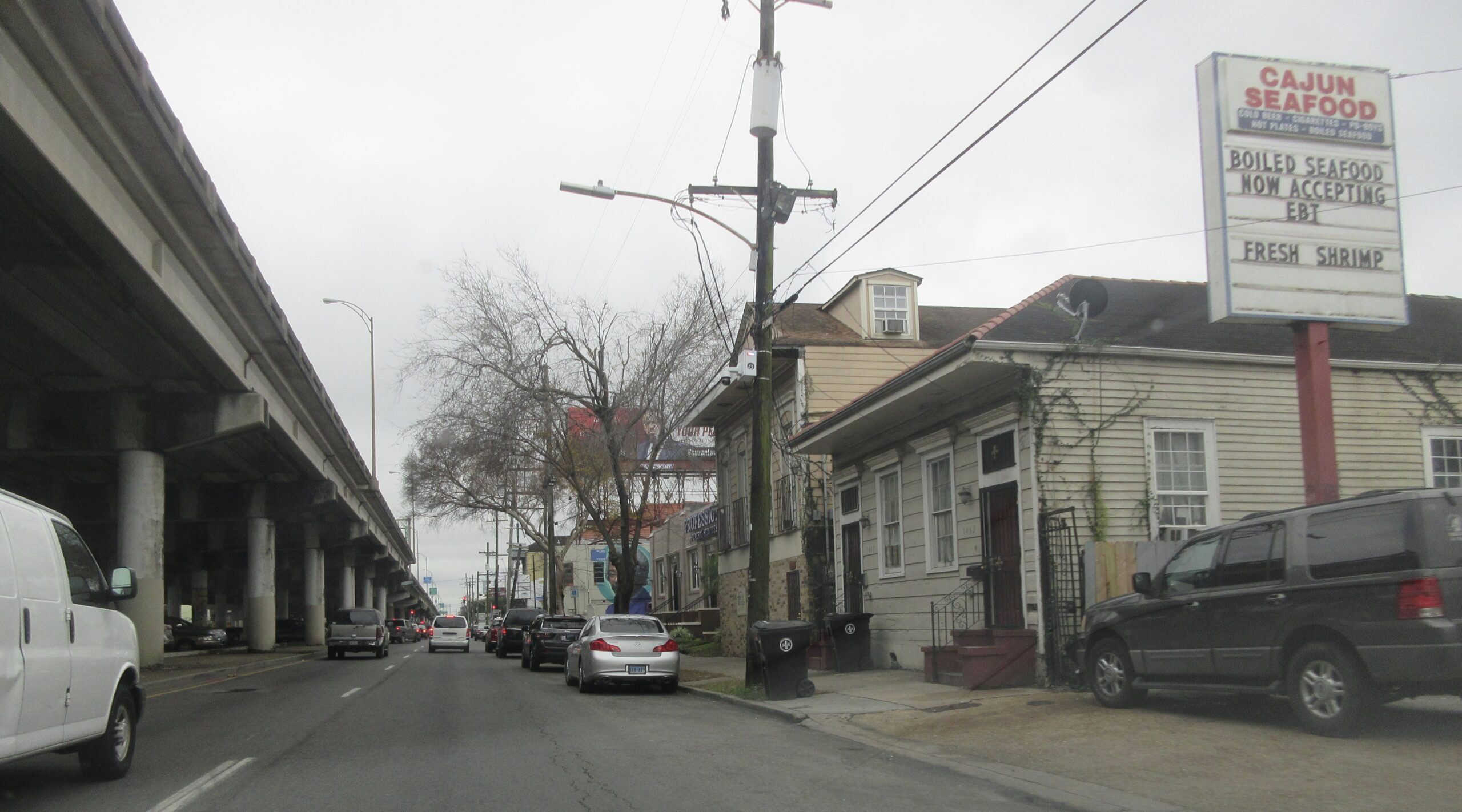Each year, hundreds of millions of cars drive across some portion of the almost 2500-mile freeway sprawling across the southern United States. The fourth-longest interstate in the country, Interstate-10 (I-10) connects major cities spanning from Los Angeles, CA through Jacksonville, FL. Of those roughly 2500 miles of expressway, 275 of them run through southern Louisiana. Passing through Lake Charles, Lafayette, and Baton Rouge, I-10’s last stop before leaving the state is the city of New Orleans. Between 1957, the year that construction of the Interstate in Louisiana began, and 1972, thirteen additional segments were built to connect I-10 to streets within the city center. Streets like Mound, Orleans, and St. Bernard Ave are all connected by a piece of I-10 called the Claiborne Expressway, also known as “The Monster”, arguably the city’s most hated piece of infrastructure.

Ariel view of I-10 near the Claiborne Corridor. (Photo by: Wikimedia).
Before the construction of the expressway in 1968, Claiborne Ave was known as the major thoroughfare operating through the heart of the Treme neighborhood. On a purely superficial level, the wide street was made distinctive from other major avenues because of the tall oak trees that lined the median strip delineating the two directions of traffic. If one were to look around, however, one would have been met with a bustling metropolitan center. Businesses lined the street and homes were interspersed amongst them. The significance of this avenue goes beyond its success as an early New Orleans commercial district. Claiborne Ave was the lifeblood of Faubourg Treme, the oldest and longest continually existing black neighborhood in the country. It rested on land that had been the site of one of New Orleans’s largest plantations before it was purchased in the late 18th century by Claude Treme.
On that very land where slaves were owned, epicenters of freedom were built. Congo Square in the heart of Treme was the only space in the city where enslaved people were able to congregate for worship on Sundays, eventually becoming a trading ground where people could buy their freedom through the sale of goods. In that very same square, the early foundations of Jazz were laid as Creole, Black, and white musicians all came to play improvisational band music.

Congo Square (Photo by: Kelley Crawford)
Centuries later, in the mid-20th century, Claiborne Ave was both a symbol of racial coexistence and a platform upon which Black entrepreneurship could be uplifted. A neighborhood defined by a strong and tolerant sense of community, Treme possessed a degree of communal self-sufficiency that distinguished it from its segregated counterparts. What was needed was provided by and for its own people.
Per the nationwide adoption of Jim Crow laws that upheld segregationist policies in many of the city’s communal spaces, Black people were effectively banned from white-owned commercial businesses. In response, the Treme community built a commercial and cultural hub along Claiborne Ave: innumerable Black-owned businesses found immense success and a consistent consumer base; the symbiosis between the community and the businesses ensured the neighborhood was thriving both financially and culturally. An enduring example of this symbiosis is the Circle Food Store at the intersection of Claiborne and St. Bernard Ave. Opened for business in 1938, the 22,000-foot store was the city’s first Black-owned full-service grocery store and is one of the longest-running Black businesses in New Orleans. Not only did the store stock local staple foods and game, but it became a one-stop shop for many community residents for a variety of services. Besides groceries, Circle Food store had a pharmacy, stocked school uniforms, and had a doctor, dentist, and chiropractor in-house for check-ups.
If the businesses lining Claiborne Ave cultivated a commercial haven for the Treme neighborhood, the median strip was the cultural equivalent. Amongst the oak trees was a community space that was utilized not only for day-to-day pleasure and relaxation but acted as a ritualized space for the observation of the Mardi Gras Indians and the Zulu parades. Native to the city of New Orleans, the cultural significance of the Black Mardi Gras Indians and members of the Zulu Krewe to the Treme area cannot be overstated.
The construction of interstates across the country has historical roots in race-based displacement and subjugation. The 1950s saw the passage of the Federal-Aid Highway Act (1956), Eisenhower’s self-proclaimed crowning piece of legislation passed during the first term of his presidency. This legislation created the 41,000-mile-long interstate that was intended to connect major cities through one continuous strip of highway. Inherent within this goal, however, were underlying judgments that prioritized the ease of white travel over the sanctity of Black homes. This was not unique to the city of New Orleans; St. Louis, Baltimore, and Nashville were all glaring examples of conscientious attempts to make cities more accessible at the expense of Black and lower-income neighborhoods. Urban planners such as Robert Moses, the mastermind behind the I-10 interstate on Claiborne Ave, were notorious for the intentional displacement of Black communities. Prior to his arrival in New Orleans, Moses had designed bridges in Long Island, NY that were purposefully shorter than the height of public buses to segregate the beaches and neighborhoods on the island by making it virtually impossible to reach the island without a car, barring the inner-city poor.
While Moses was pushing plans forward for the construction of I-10 through the Treme community, he was concurrently devising plans to build an expressway through the French Quarter. The response to construction plans in the Vieux Carre (French Quarter) was amplified by national attention and organized responses from groups of white elite preservationists who successfully thwarted Moses’ plans. In the shadows of that success of white preservationists was the sorrow of the Black community of Treme that had been both ignored and displaced by the Claiborne Ave 1-10 overpass. Black business owners and residents protested against the idea that their historic neighborhood should be compromised by the construction of cement pillars and paved streets; unlike the Vieux Carre Association, their protest was never acknowledged by the city of New Orleans, much less the country. The patterns of white flight in the early 1960s due to school reintegration mirrored the perspectives that many white residents had about the quality of life within the inner city. Considering that many white people outside of Treme found the city unsuitable to live in post-integration, it comes as no surprise that the complete eradication of the neighborhoods that remained was perceived as a negligible concern.

Claiborne Avenue next to I-10. (Photo by: Infrogmation of New Orleans).
All too often, the mechanism of construction is motivated by commercial interests or ease of accessibility. The ethics of such motivations are proven null, however, if access is considered a privilege and not a given right. Colonization ideology continues to prioritize material benefit over the livelihoods of communities considered alternative.
Over the last decade, the Treme neighborhood has displayed its resilience repeatedly. The Mardi Gras Indians and Zulu Parades still march down Claiborne Ave in remembrance of the community that was disregarded. Those who remain line the street decorated with murals of the foregone oak trees to watch the deeply ritualistic spatial movement occur.
This piece was edited by Lily Plowden as part of Professor Kelley Crawford’s Digital Civic Engagement course at Tulane University.
 NOLAbeings
Multimedia artist Claire Bangser created NOLAbeings as a portrait-based story project that marries...
NOLAbeings
Multimedia artist Claire Bangser created NOLAbeings as a portrait-based story project that marries...
 Data corner: Adobe Suite (create a PDF, social media graphic, presentation, edit a photo and video
Data corner is where you go to work with analytics and top tech skills. It takes on everything from PERL and SQL to Canva and Sprout Social.
Data corner: Adobe Suite (create a PDF, social media graphic, presentation, edit a photo and video
Data corner is where you go to work with analytics and top tech skills. It takes on everything from PERL and SQL to Canva and Sprout Social.
